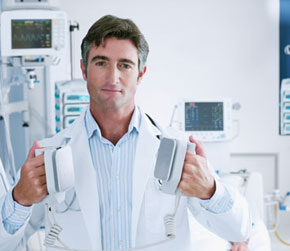Defibrillator Procedure
Finding the time to eat right and exercise is tough, especially in a very busy day-to-day life, including a job, kids and other activities. But a full life of not taking care of your body may lead to heart disease, due to the buildup of plaque in the arteries supplying blood to the heart. That is a scary situation, since the heart is so important in our bodies. Without it, we would not be able to continue living. For this reason, there has been a lot of effort put into developing procedures that allow for the heart to continue functioning. One of these is a defibrillator procedure. Others include surgeries, insertion of pacemakers and diet/exercise.
What is a Defibrillator Procedure?
As the heart disease sets in, it doesn’t beat as strongly as it once did. This can lead to a sluggish heart and to keep up with the loss of pumping power, the heart can tell itself to start beating at a faster rate. This is due to the fact that the body is not getting enough nutrients. These nutrients are important because without them, we wouldn’t be able to function as healthy, living organisms. While the heart used to be able to pump 1 time to get a certain amount of blood out and to the other vital organs, it may take 2-3 beats to move the same amount of blood from a diseased heart. This can be bad news, as the heart having to beat that much more means it gets worn out more quickly. This creates a snowball effect, where the heart is only further deteriorating.
When the heart must beat faster, it is referred to as tachycardia. This is defined as a faster than normal heartbeat. When the heart has to do this, it can sometimes get its signal mixed up and not work anymore. This is when a heart attack can happen. This can also happen when an artery gets clogged and denies oxygen to the heart muscle. At any rate, when this signal is interrupted, a defibrillator procedure is the solution. This is a way to resetting the signal to the heart. This includes “shocking” the heart back to life.
Who Can Administer a Defibrillator Procedure?
The most qualified person to administer a defibrillator procedure is a doctor. They are well-trained and know exactly how a defibrillator works. But these aren’t the only people who can use the machine. There are devices called AEDs (automated external defibrillators), which work to do the same thing as the defibrillators found in hospitals, but these are sold over-the-counter to be in homes and businesses. Any person can use the AED to do a defibrillator procedure on a person who is having a cardiac event.
It is important that the person doing the defibrillator procedure is trained, but in a pinch, any person can use an AED. These machines have very simple instructions, displayed via pictures or through a voice talking you through it. Either way, you should have no problem using the machine, even under the stress of someone having a heart attack in your presence.

